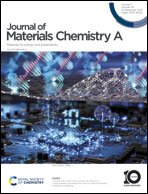Understanding the limits of Li-NMC811 half-cells†
Abstract
As we push the boundaries of state-of-the-art lithium-ion intercalation materials, such as nickel-rich chemistries, the ability to isolate and understand specific degradation and performance limitations is becoming increasingly important. Half-cells, wherein lithium metal is employed as a dual counter and reference electrode, are commonly used in industry and academia for this purpose. However, the high reactivity of lithium metal drives premature electrolyte degradation and limits cell lifetime, bringing into question the reliability and validity of this cell configuration. Here we explore the limitations of half-cell studies of LiNi0.8Mn0.1Co0.1O2 (NMC811) electrodes with commercially relevant loading. We identify the failure mechanism of this cell configuration through a combination of electrochemical, chemical, and spectroscopic techniques and show that the Li has a direct detrimental impact on the NMC811 chemistry. Our measurements show that vinylene carbonate is critical for these half-cell studies and underpins the cycle limits. Furthermore, we demonstrate the use of Li4Ti5O12 (LTO) as an alternative counter electrode for understanding the performance of NMC positive electrode materials, due to its high coulombic efficiency and low reactivity with the organic carbonates routinely employed in lithium-ion battery cell chemistries. These data confirm that NMC811 electrodes can tolerate high voltages (stressed) conditions and that cell failure is mainly a result of crossover effects.

- This article is part of the themed collection: #MyFirstJMCA


 Please wait while we load your content...
Please wait while we load your content...